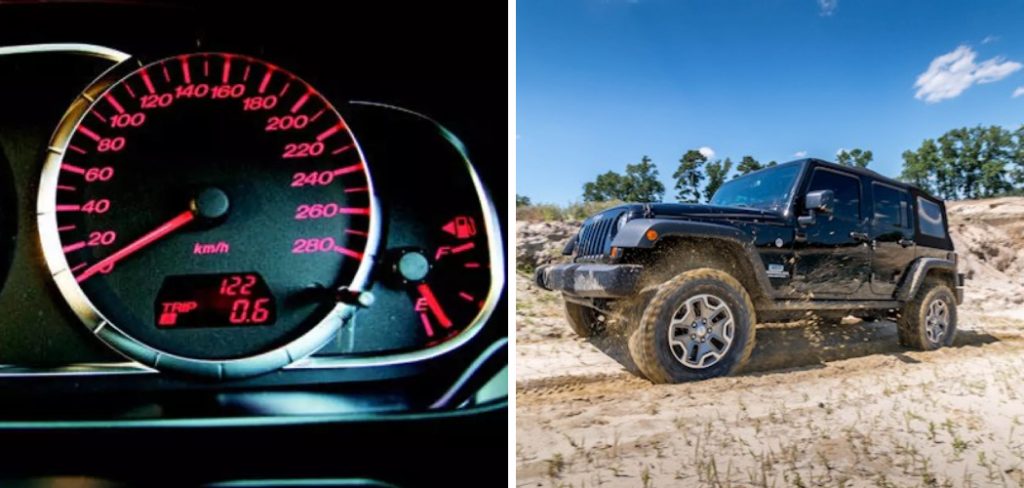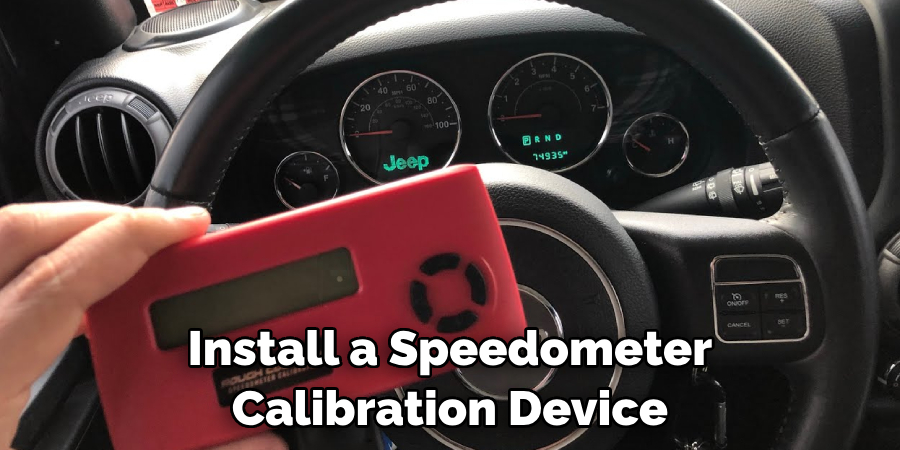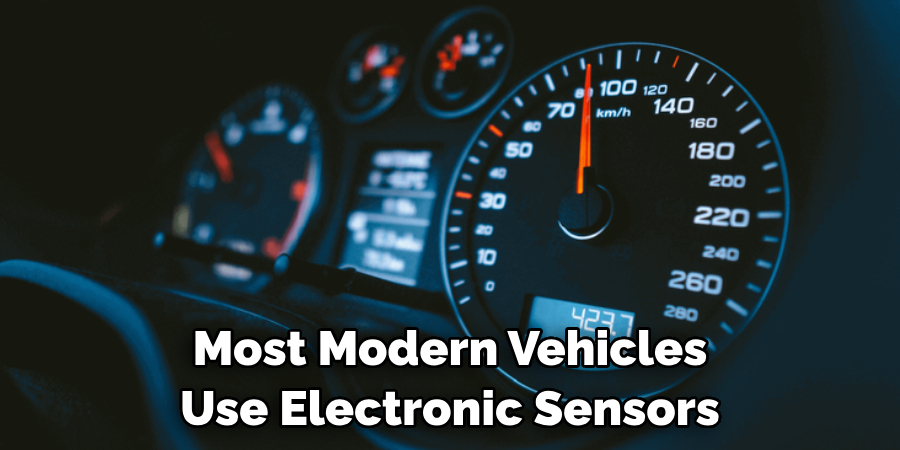If you have recently upgraded your tires to larger ones, you might have noticed that your speedometer is now reading an inaccurate speed. This can be a frustrating problem, but it can be easily solved with the right tools and knowledge. In this blog post, we will guide you on how to adjust speedometer for bigger tires and ensure a smooth and safe driving experience. So let’s get started!

Can You Adjust the Speedometer for Bigger Tires?
As a car enthusiast, upgrading your vehicle is always a thrilling experience. From switching out the exhaust system to a set of bigger and meaner wheels, you can make seemingly endless modifications to improve performance and style. However, upgrading those tires to something bulkier and more aggressive can sometimes bring up a new issue: What happens to your speedometer?
The short answer is yes, you can adjust your speedometer for bigger tires. Though the process may vary depending on the specifics of your vehicle, taking the time to actually fix your speedometer is crucial for ensuring you can drive safely and legally on the road.
Why Should You Adjust Speedometer for Bigger Tires?
Bigger tires can be a great addition to any vehicle, providing a more rugged and adventurous look. However, many people are unaware that installing larger tires can also impact their speedometer readings. When you add bigger tires to your vehicle, you’re essentially increasing the circumference of the wheels, which means it takes more time to complete one rotation.

This increase in circumference can often lead to inaccurate speedometer readings, causing you to think you’re driving slower or faster than you really are. Therefore, adjusting your speedometer is essential, not only for safety reasons but also to ensure you don’t receive any unwanted speeding tickets.
By simply recalibrating your speedometer, you’ll still experience the benefits of bigger tires while maintaining accurate speed readings.
A Simple Guide on How to Adjust Speedometer for Bigger Tires
1. Calibrate Your Speedometer
Calibrating your speedometer is the first step in adjusting it for larger tires. You can use a GPS application on your smartphone to determine whether your speedometer is reading correctly. Drive your vehicle for a few miles while measuring the speed with the GPS app. If your speedometer is reading higher or lower than the GPS measurement, it’s time to calibrate it.
2. Install a Speedometer Calibration Device
After calibrating your speedometer, the next step is to install a speedometer calibration device. This device will help adjust the speedometer reading to match the size of your tires. You can buy a calibration device from your local auto parts store or from an online store.

They come in two types: mechanical and electronic. Mechanical calibration devices are less expensive and easy to install, while electronic calibration devices are more accurate and can be programmed to match tire size.
3. Determine the Right Gear Ratio
Gearing down or up will also affect how your speedometer reads. You need to know the right gear ratio for your vehicle and your new tire size. You can find this information in your owner’s manual or by using an online gear ratio calculator. Knowing the right gear ratio will help you determine the right calibration for your speedometer.
4. Install New Gears
If your vehicle has a mechanical speedometer, you will need to install new gears in the transmission or the transfer case to adjust for larger tires. This can be a more complex process and might require professional help. However, if your vehicle has an electronic speedometer, you can easily adjust it using a programmer.
5. Use a Speedometer Recalibration Tool
A speedometer recalibration tool is another option for adjusting your speedometer for larger tires. This tool connects to your vehicle’s OBD-II port and communicates with the electronic control unit (ECU) to change the tire size settings. This process is easy and can be done by following the instructions provided by the manufacturer.
6. Check the Speedometer Reading
After installing a calibration device or recalibrating your speedometer, it’s essential to double-check the reading. Use the GPS app again and drive for a few miles to ensure that your speedometer is now reading accurately.
7. Test Drive Your Vehicle
Once you have adjusted your speedometer, take your vehicle for a test drive. Pay attention to the speedometer reading and compare it with the GPS measurement. If everything matches, then congratulations! You have successfully adjusted your speedometer for bigger tires.
5 Considerations Things When You Need to Adjust Speedometer for Bigger Tires
1. Gear Ratio
One of the main considerations when adjusting your speedometer for bigger tires is the gear ratio of your vehicle. This ratio determines the number of revolutions of the driveshaft for each revolution of the tires. When larger tires are installed, it changes the overall diameter and circumference of the tire, which can affect the gear ratio and cause inaccuracies in your speedometer reading.
2. Tire Size
The size of your new tires is another important factor to consider when adjusting your speedometer. The actual size of a tire can vary slightly even within the same brand and model, so it’s crucial to measure them accurately before making any adjustments. An online tire size calculator or consulting a mechanic can help you determine the correct size to input into your speedometer.
3. Speed Sensor Calibration
Most modern vehicles use electronic sensors to measure speed and send signals to the speedometer. When changing tire sizes, these sensors may need to be recalibrated in order to read the new tire size accurately. This can usually be done through a diagnostic tool or by manually entering new values into the vehicle’s computer system.

4. Aftermarket Speedometer Calibration Devices
If your vehicle does not have electronic sensors or prefers not to recalibrate them, aftermarket devices can be installed to adjust your speedometer for bigger tires. These devices typically work by intercepting and modifying signals from wheel speed sensors or by connecting directly to the vehicle’s computer system.
5. Professional Installation
Adjusting a speedometer for bigger tires may require specialized knowledge and tools, so it’s important to consider seeking professional installation services if you’re unsure about how to do it yourself. A mechanic or automotive technician will have experience with this type of adjustment and can ensure that it is done correctly for accurate readings while driving.
5 Benefits of Adjust Speedometer for Bigger Tires
1. Improved Accuracy
One of the main benefits of adjusting your speedometer for bigger tires is improved accuracy. Changing the size of your tires can throw off the calibration of your speedometer, resulting in an inaccurate reading of your vehicle’s speed. This can lead to potential speeding tickets and affect other aspects of your vehicle’s performance, such as fuel efficiency and odometer readings.
2. Better Handling
Bigger tires can also improve the handling of your vehicle. With a larger surface area in contact with the road, bigger tires provide better traction and stability, especially in off-road or harsh weather conditions. Adjusting your speedometer ensures that you are aware of your actual speed and can make necessary adjustments while driving for a smoother and safer ride.

3. Preserves Engine Life
Incorrectly calibrated speedometers due to bigger tires can also strain your engine unnecessarily. This is because the engine has to work harder to maintain a certain speed when the actual speed is higher than what is shown on the speedometer. Over time, this can lead to premature wear and tear on engine components, reducing their lifespan and potentially resulting in costly repairs.
4. Maintains Warranty Coverage
If you have a new vehicle with a warranty, adjusting your speedometer for bigger tires may be necessary to maintain coverage. Many manufacturers specify that any modifications made to the original equipment may void the warranty unless properly calibrated by a professional mechanic or dealership.
5. Avoid Legal Issues
Driving with an inaccurate speedometer due to bigger tires can also land you in legal trouble if you are pulled over by law enforcement for speeding. Even if you are not intentionally breaking the law, an incorrect reading on your speedometer could result in hefty fines or even license suspension, depending on local laws and regulations. Adjusting your speedometer for bigger tires ensures that you are always aware of your true driving speed and avoid any potential legal issues.
Conclusion
Adjusting your speedometer for bigger tires may seem daunting, but it’s a simple process with the right tools and knowledge. Calibrating your speedometer, installing a speedometer calibration device, determining the right gear ratio, and consulting a professional are all steps to ensure that your speedometer reads accurately.
It’s important to test your speedometer on different road conditions to ensure that your adjustments are correct. Now that you know how to adjust speedometer for bigger tires, you can enjoy a smooth and safe driving experience.

About
JeepFixes Team is a skilled author for Jeep Fixes, bringing 6 years of expertise in crafting a wide range of jeep fixes. With a strong background in jeep fixes work, JeepFixes Team’s knowledge spans various types of fixtures, from decorative pieces to functional hardware, blending precision with creativity. His passion for jeep fixes and design has made him a trusted resource in the industry.
Professional Focus:
Expert in Jeep Fixes : JeepFixes Team aesthetic specializes in creating durable and innovative jeep fixes, offering both appeal and functionality. His work reflects a deep understanding of jeep fixes techniques and materials.
Sustainability Advocate : He is dedicated to using sustainable practices, ensuring that every fixture is crafted with eco-friendly methods while maintaining high-quality standards.
In his writing for jeep fixes, JeepFixes Team provides valuable insights into the latest trends, techniques, and practical advice for those passionate about jeep fixes, whether they are professionals or DIY enthusiasts. His focus on combining artistry with engineering helps others discover the true potential of jeep in design.
